00 POLLUTION // TORRE TELEFONICA DIAGONAL ZEROZERO
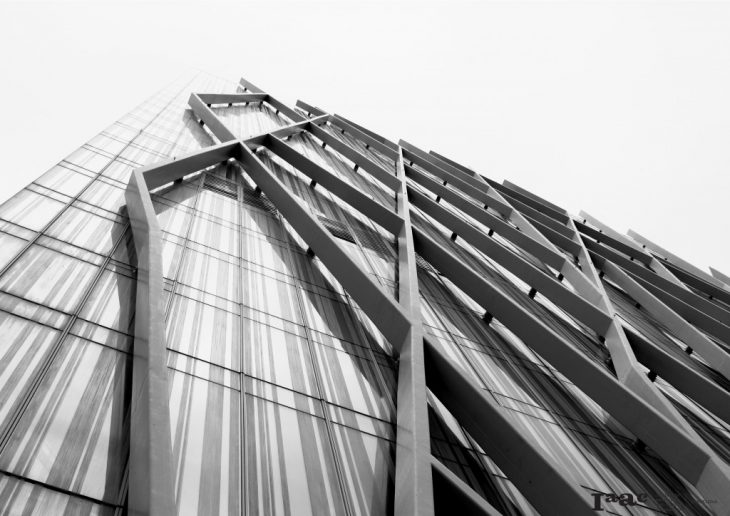
BRIEF
Metabolic Iconic Roofs studio is about the comprehension of metabolic processes and how they coexist within architecture, what are their inputs and outputs, which are their working environments and the relationship with buildings and built environment.
By 2050, 70% of world population will be living in cities, what will the icons of a city be by then?
Barcelona has a very distinctive skyline where architecture icons have become souvenirs and fridge magnets. Metabolic roofs studio works around the idea of hacking and retrofitting these icons to transform them into climatic machines that could become the new icons for super populated next century cities. We will transform the roofs of the most iconic buildings of the city and convert them into metabolic elements capable of tackling climate remediation topics.
BUILDING
Building: Diagonal Zero-Zero
Architects: EMBA (Estudi Massip-Bosch Arquitectes), founded and led by Enric Massip-Bosch
Location: North end of Avenida Diagonal, Barcelona, Catalonia
Use: Corporate headquarters of Telefonica SA (Built and land owned by the City of Barcelona)
Height: 110m above ground level
Stories: 25 floors + 3 basement levels
Years: April 2008 – February 2011
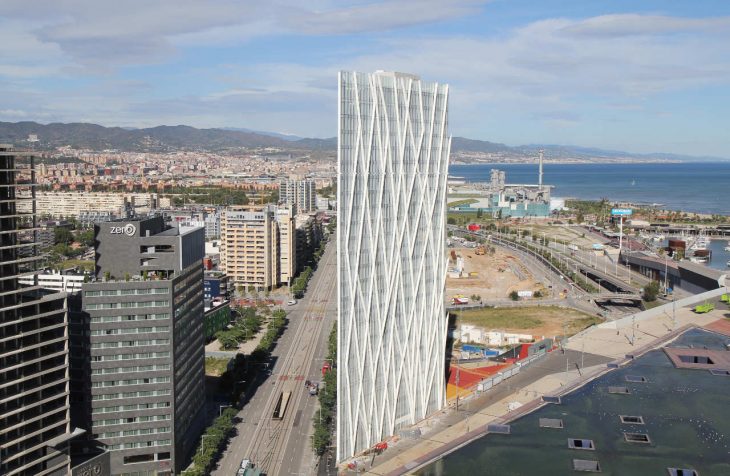
The building is located by the sea at the origin of Barcelona’s main thoroughfare, at the North end of the Avenida Diagonal, giving it the name ‘Diagonal ZeroZero’. The building takes the form of the linearity of the street on the perimeter as a generator of the outer shape, creating a trapezoidal prism. The building stands out and is visible from both the city and the seaside. It borders the large expanses of public urban space of the ‘Forum’, a still developing area, and the consolidated city. The immediate surroundings consist of isolated buildings in a diverse context of different scales and uses that generate at the same time a metropolitan center and a local neighbourhood side by side. The building is split into two main parts, the lower third is public and the upper two thirds are used for administration purposes.
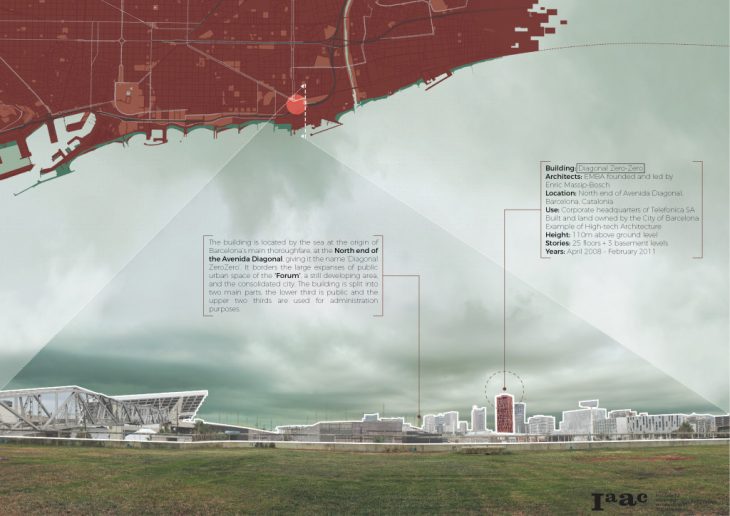
The facade is composed of a modular curtain wall that is covered in white aluminium profiles and an extremely clear glass. The printed glass design follows a vertical pattern, which emphasizes the building slenderness.
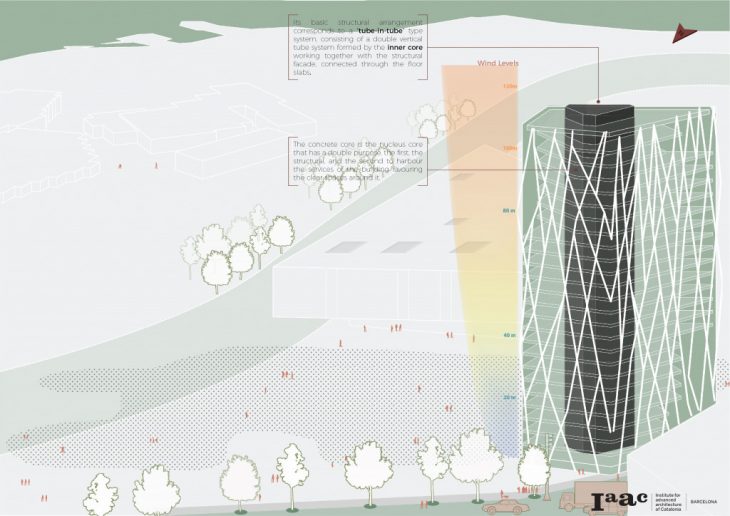
One of the biggest freeways in Barcelona, the Ronda Litoral, has high traffic in certain hours. Exhaust from the cars directly affect the air quality of the forum area. One of the main air pollutants in Spain is made by cars; nitrogen dioxide is a reddish-brown irritant gas with a pungent, acrid smell and 60% comes from traffic.
The Forum and Diagonal ZeroZero building is located in the El Besòs i el Maresme area. The area is mainly residential with recreational areas and educational buildings. For our project this fact is very alarming because Spain is one of the top five countries worst affected by pollution in the EU. Being subjected to pollution, whether in the short or long term, can have major effects on one’s health.
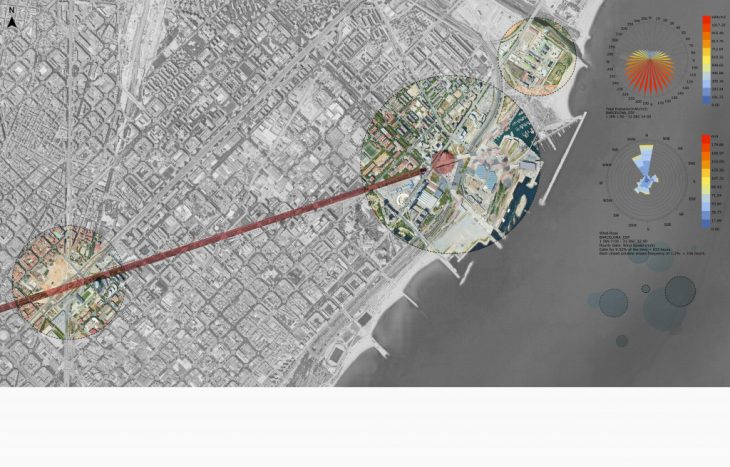
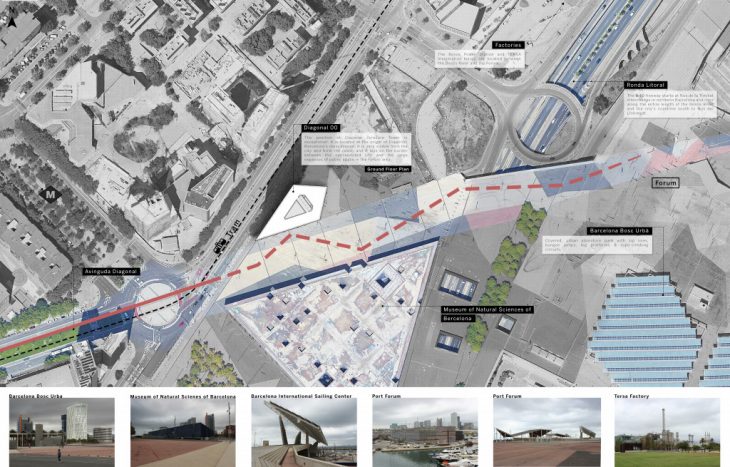
PHENOMENA
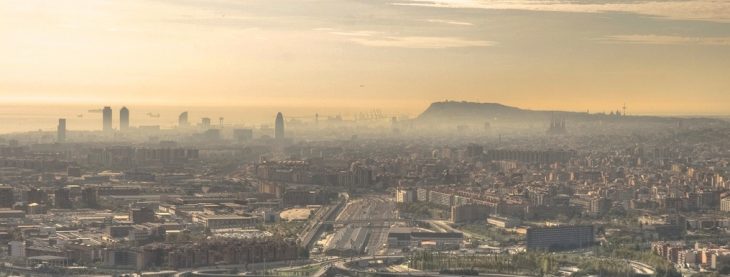
Barcelona has been battling with environmental problems for some time. One of the biggest issues right now is urban pollution in cities.
Air pollution is caused by solid and liquid particles and certain gases that are suspended in the air. These particles and gases come from car and truck exhausts, factories, dust, pollen, mold spores, volcanoes and wildfires. Primary air pollution sources are: cooking, dust, incomplete
combustion and automobile emissions, and secondary sources include chemical reactions in the atmosphere.
AIR POLLUTION
Spain is plagued by three main air pollutants:
Nitrogen Dioxide which is caused by traffic and is predominantly a big problem in big cities;
PM10 particle matter, consisting of dust, ash, and soot which is caused by traffic, heating systems,
industry and construction;
Ozone, a pollutant which is prevalent during hot weather and can spread long distances.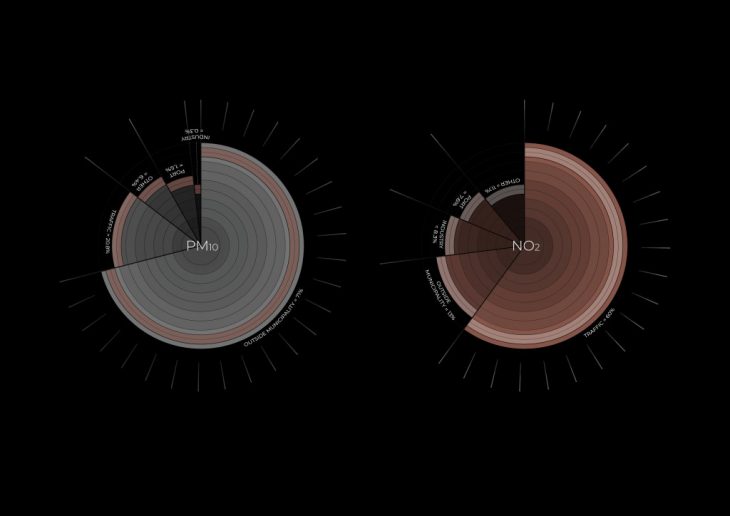
Spain is one of the top five countries worst affected by pollution in the EU. Being subjected to pollution, whether in the short or long term, can have major effects on one’s health. More than half of Spain does not meet EU air quality regulations. According to the most recent
annual report from the European Environment Agency (EEA), 38,600 premature deaths in Spain in 2015 were due to pollution and 27,900 of these were caused by particle pollution.
There have been many recent studies showing the direct correlation between the number of hospital admissions and spikes in pollution.
DANGERS OF AIR POLLUTION
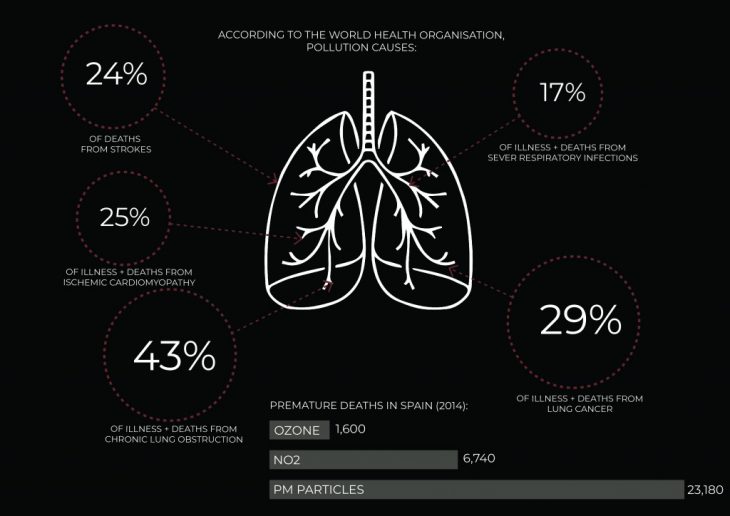
So based on our research, our main goal was to come up with a metabolic system that would be placed on top of our building and would be able to clean the air pollution.
COLLAGE BASED ON AIR CLEANING CONCEPT
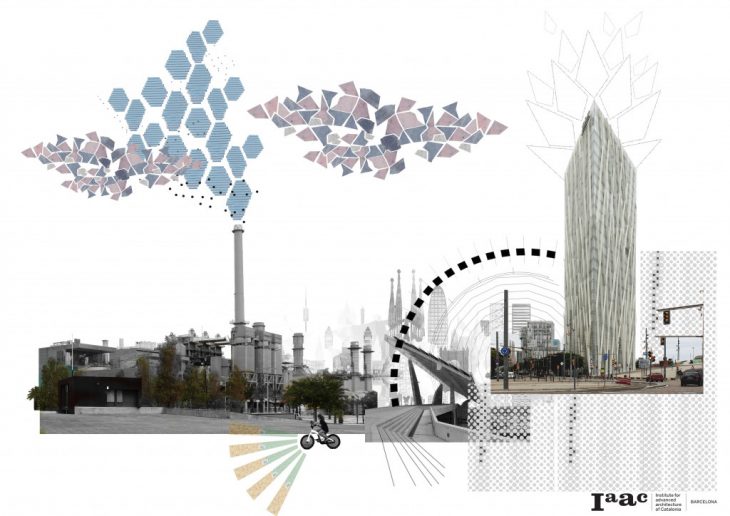
RESEARCH
Designing by nature.
Biomimicry is the design and production of materials, structures, and systems that are modelled on biological entities and processes. Our research us took us into the process of looking at nature for inspiration. We looked at what are natural air cleaners which led us into looking at the construction and function of spider webs as well as stomata.
Later on in our design, we looked at the hexagon shape to influence our structure which was inspired by bees and their honeycomb.
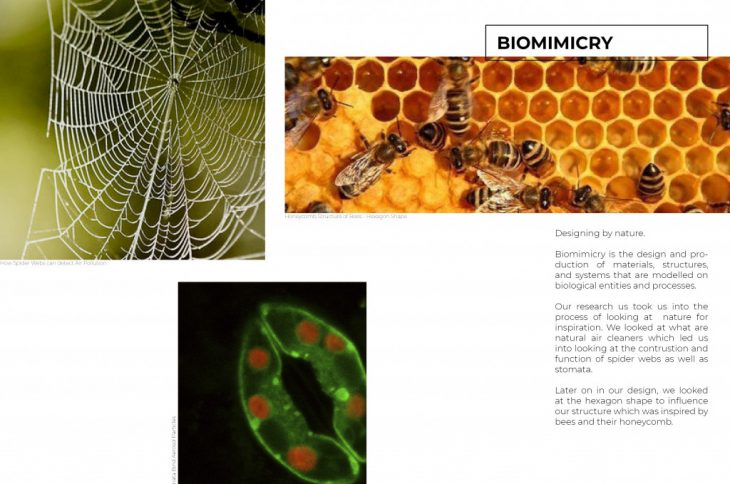
Hexagons are found in nature in various forms due to their efficiency. Honeycomb is the most well known with the geometrically perfect shape creating homes for bees and their honey. In a hexagonal grid each line is as short as it can possibly be, if a large area is to be filled with the fewest hexagons. This means that honeycomb requires less wax to construct and gains lots of strength under compression. Hexagons appear in nature as they’re the most efficient way to fill a space with the least amount of material.
Spider webs are electrostatically charged, making them perfect for capturing prey, pollen & pollutants. They are therefore good indicators of environmental health. They are made up of intertwined silk, where the compound of silk attracts water molecules that coat the web, making it electrostatically charged and therefore able to attract charged objects that come close to it.
DESIGN
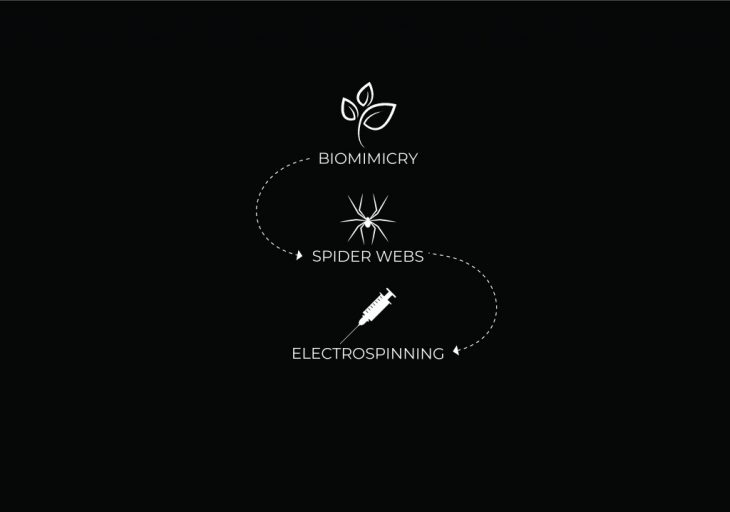
Based on the concept that spider webs are natural indicators of pollution within an environment, we wanted to create a large-scale design that would do the same thing. Our initial design was based on this image.
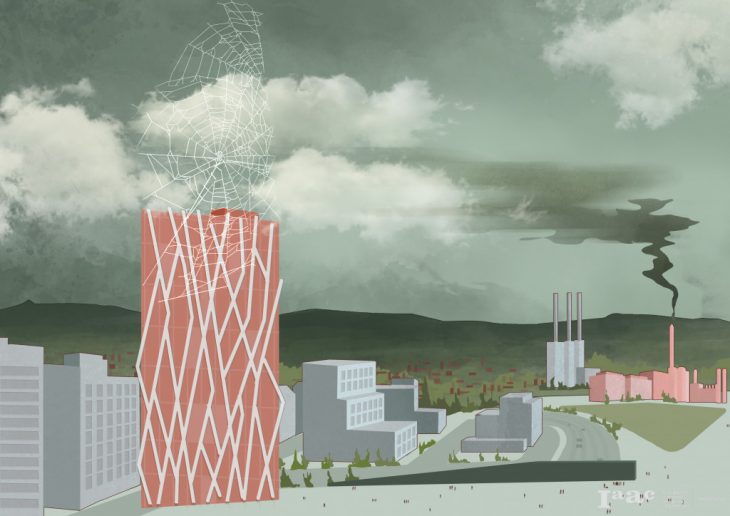
We researched a process called electrospinning which is a fiber production method that uses electric force to draw charged threads of a polymer solution. There is a strong electrostatic field that induces repulsive forces within the solution which helps in creating nano fibers that creates a nano filter which could be used to filter the air. We researched many materials that are biodegradable and that could be electrospun. We also looked into how to produce energy that would create this electric force. Wind would be the most efficient source of energy and could easily be placed on top of the building.
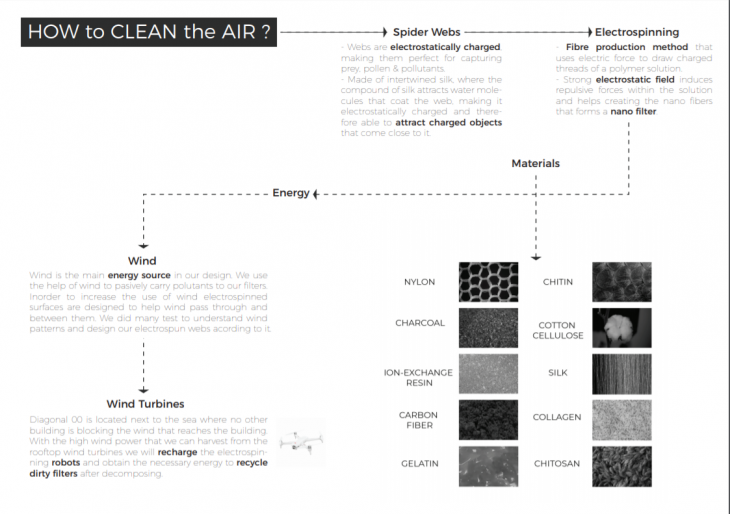
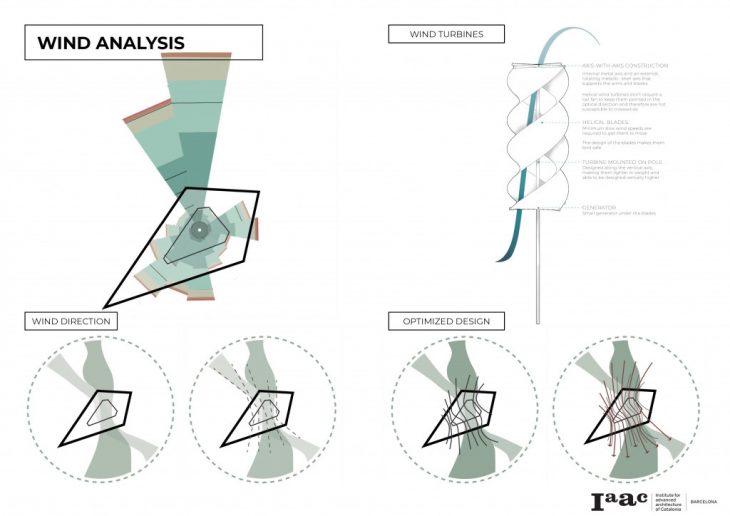
Based on the structural facade of the building, we were able to come up with a design that could be built up from it and form wind channels.
INITIAL PATTERN OF WIND CHANNELS
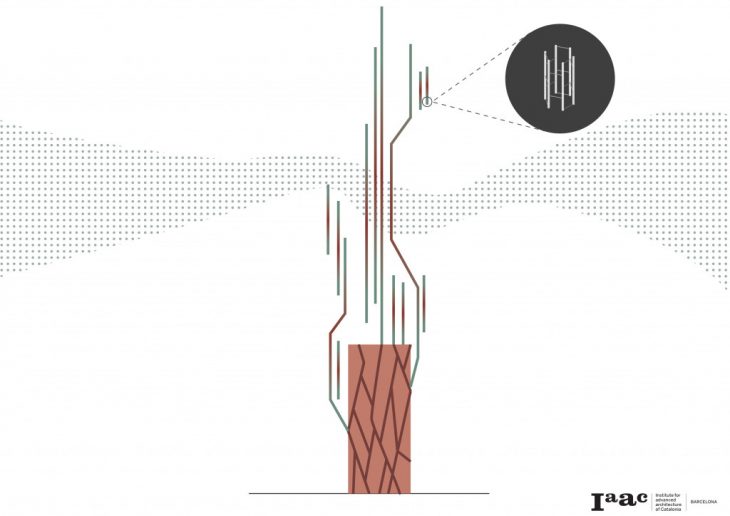
These wind channels would be formed from hexagonal structures that would hold the electrospun filters. We looked at wind analysis and found that the hexagonal pattern was the most efficient in terms of material efficiency as well as wind channeling.
ELECTROSPUN FILTER DESIGN
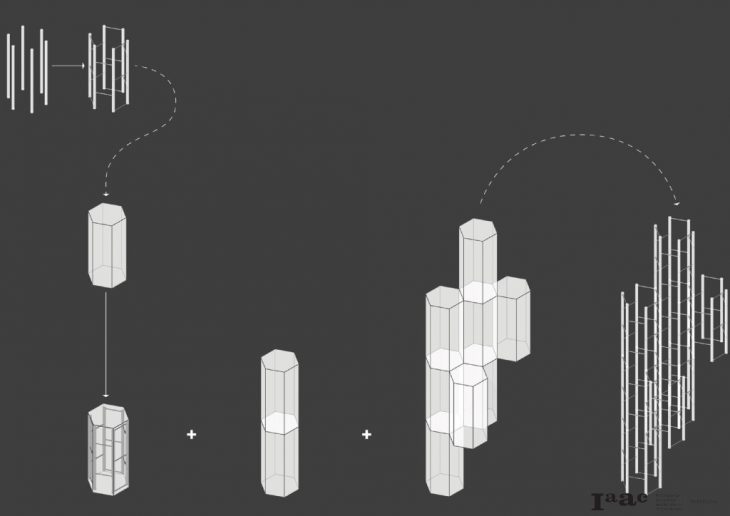
WIND ANALYSIS BASED ON HEXAGONAL PATTERN
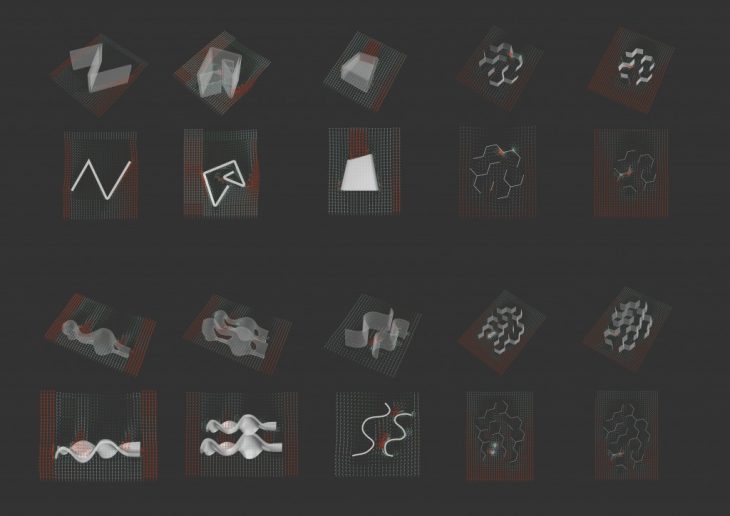
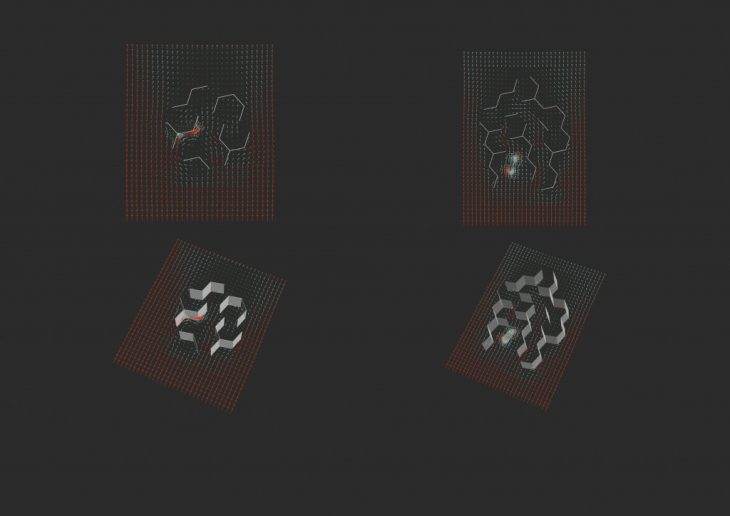
PLAN BASED ON WIND
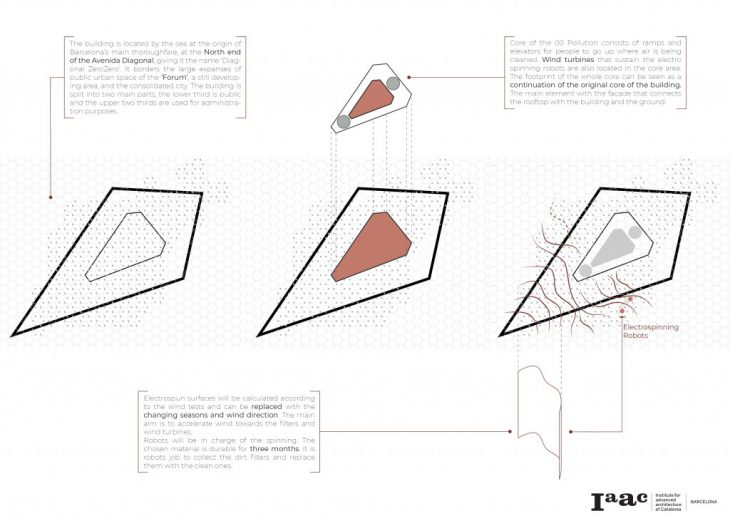
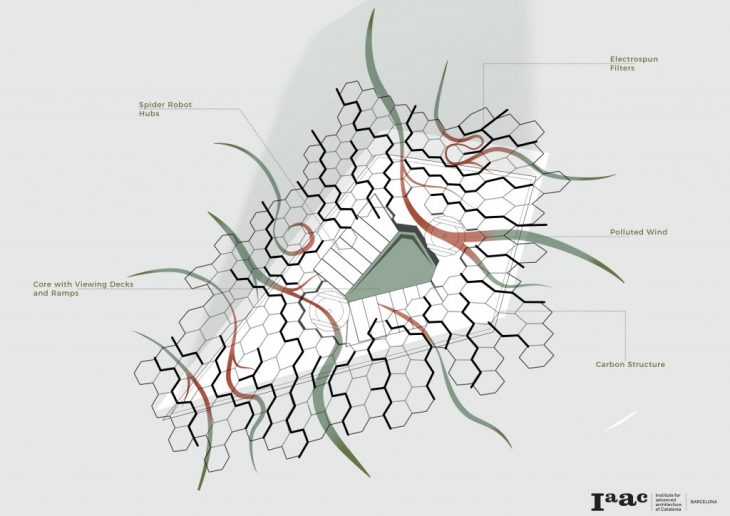
PROTOTYPING
Our plan was to build a prototype that would show the electrospinning of nano fibers.
Electrospinning consists of a process where a high voltage is applied to a liquid droplet, the body of the liquid becomes charged, and an electrostatic repulsion counteracts the surface tension and the droplet is stretched; at a critical point a stream of liquid erupts from the surface which is known as a Taylor Cone. Once the solution reaches the collector plate, a formation of uniform web of fibers is created at a nanometer scale.
The Collector Plate is placed inside the air-tight box and will be where the polymer solution forms the electrospun nano filter. The collector plate is at low potential whereas the needle will be at high potential which will create the force for which the elongated nano fiber to extend.
The Voltage required is dependent on the dielectric constant of the solvent and the viscosity of the solution. When the force overcomes the surface tension and viscous forces, a jet travels to the collector which forms an elongated nano fiber as the solvent evaporates.
The Needle and Syringe is connected to the high voltage and contains the polymer solution that will be electrospun. The syringe with the polymer solution will need to be pushed at a constant pressure into an air-tight box towards a collector plate. The polymer solution will create a Taylor Cone once it extrudes and will create a nano fiber filter on the collector plate that will be electrostatically charged.
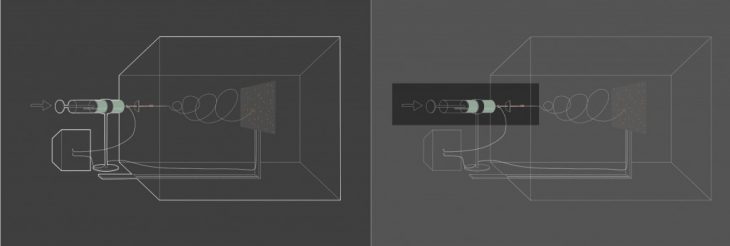
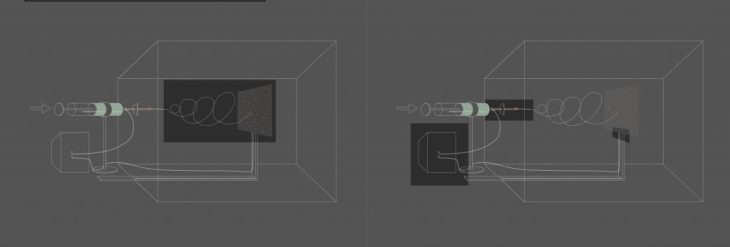
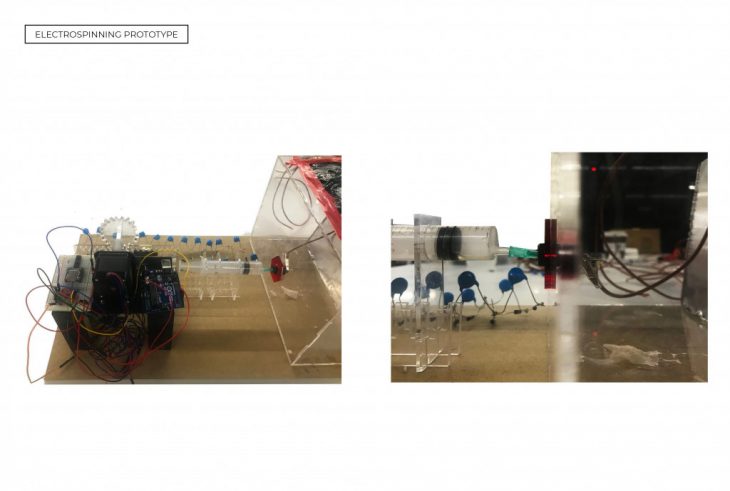
We also build a model of the roof of our building showing the hexagonal pattern of the filters and tested that wind channels.
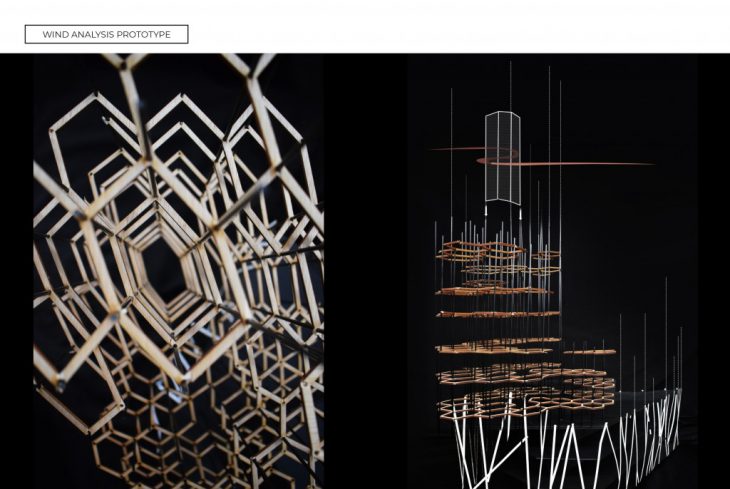
FINAL DESIGN
The design is based on the wind analysis in order to optimize and maximize the wind in the filter system. The design was also largely influenced by the original facade of the building. These vertical ‘bamboo’ elements were the starting point for the extruding vertical structure in which the filter system would be attached.
Core: The core is an extension of the original building’s core which forms that structural support of the metabolic roof structure.
Hubs: There are three hubs that extrude from the core, creating platforms that allow for the Robotic Spiders to recharge and deposit the collected pollution particles.
Robotic Spiders: There will be robotic spiders that will create the electrospun filters.
Filters (Hexagon Shape): Based on the structural shape of the hexagon seen in nature from honeycomb, our structural design was adapted. By using the hexagon as the main base shape and tessellating it, we came up with a pattern for the electrospun filters. Each filter is constructed by six vertical elements that are connected by small horizontal supports. These hexagons are then covered by the robotic spiders in electrospun material, making them electrostatically charged and able to collect dust and smog particles from the air. This structure is then multiplied in a mathematically calculated pattern which optimizes the wind direction as well as to create a lightweight structure.This pattern is based on the logic of a spider web.
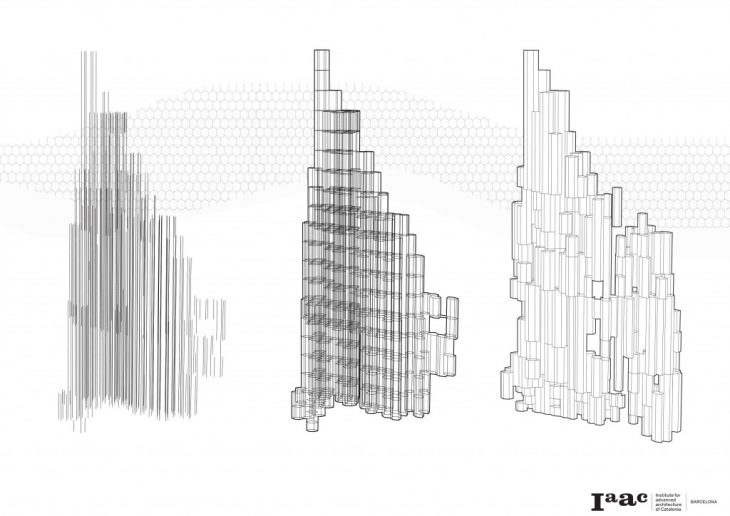
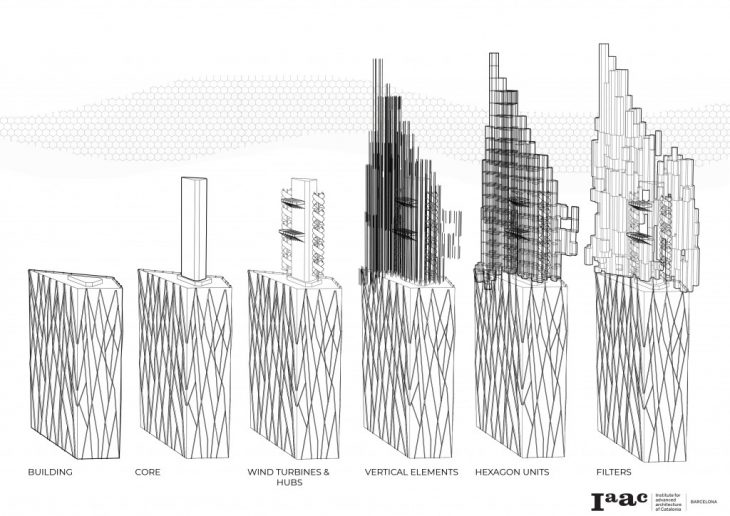
RENDER
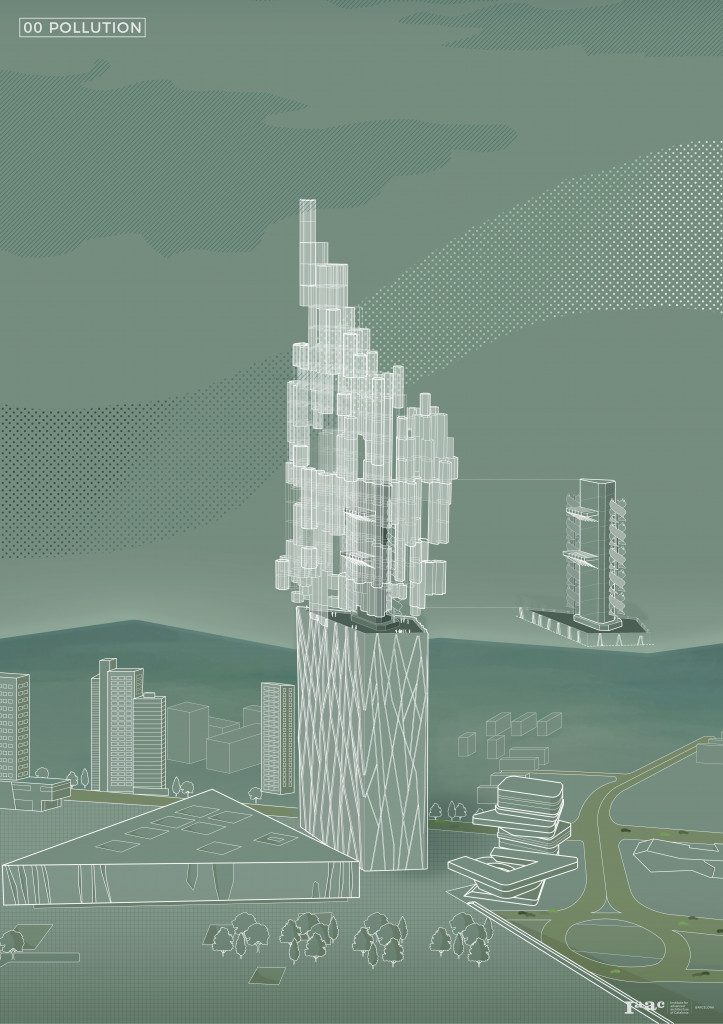
HYPERDRAWING OF ROOFTOP
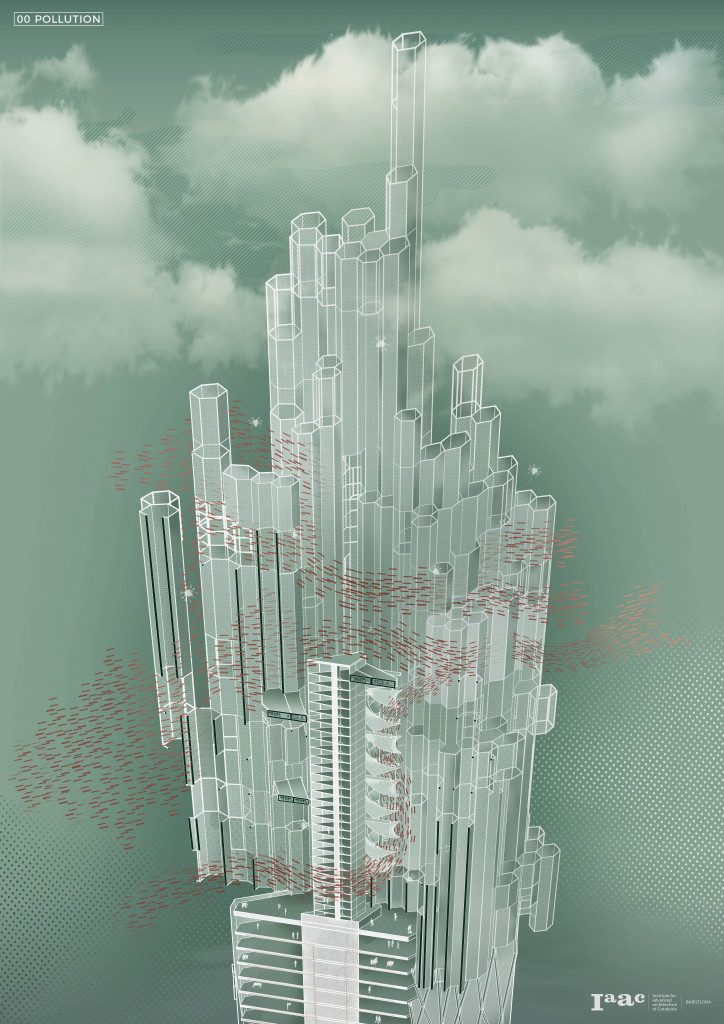
RENDER OF 2050 VISION
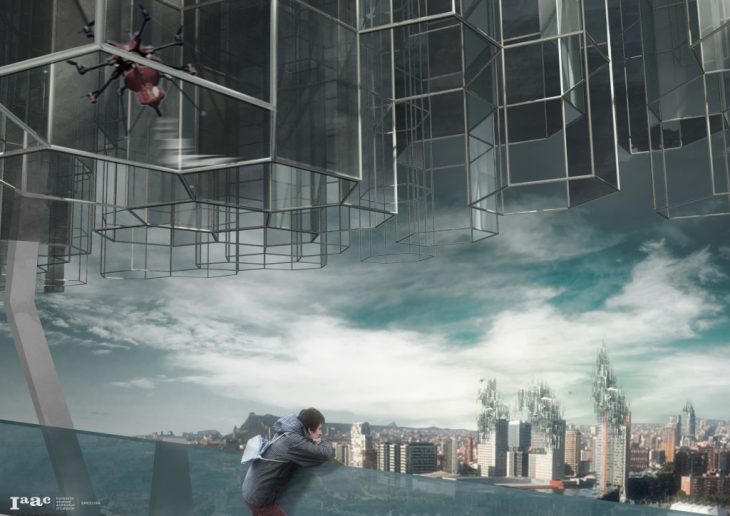
RENDER OF DESIGN
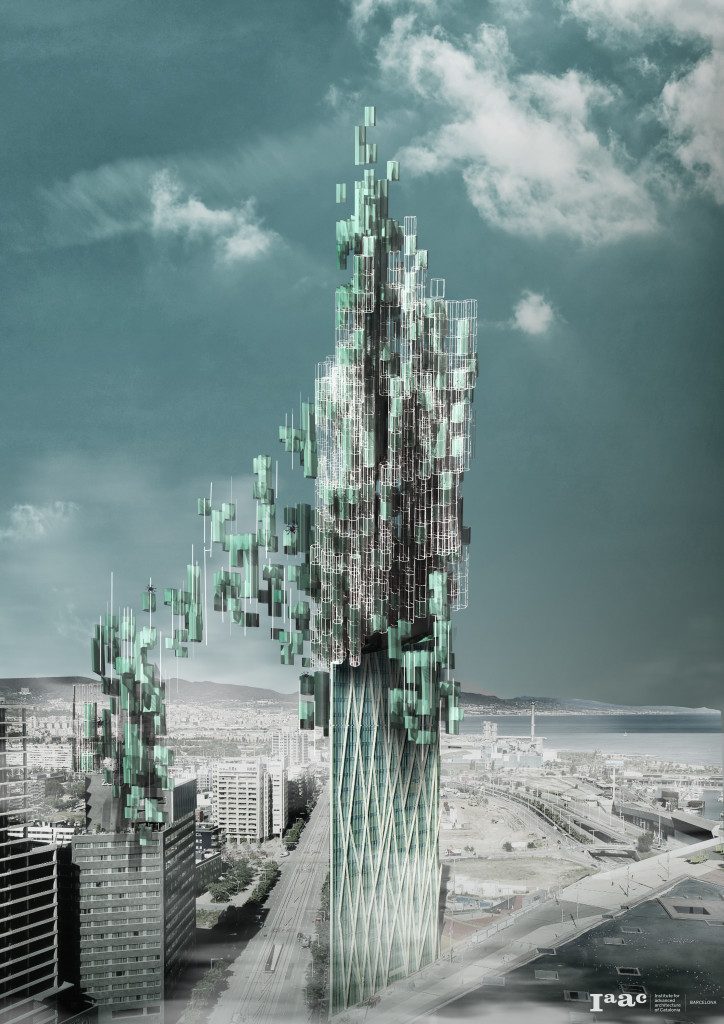
</p>
Metabolic Roof Structures / 00 Pollution is a project of IAAC, Institute for Advanced Architecture of Catalonia developed at the Master in Advanced Architecture in 2019 by:
Students: Deniz Akyürek, Hanna Lepperød, & Ilaena Mariam Napier
Faculty: Javier Pena & Oriol Carrasco
Assistant: Yigitalp Behram